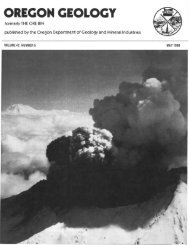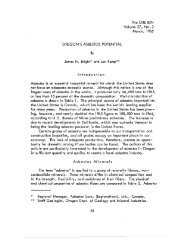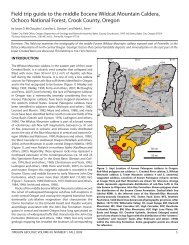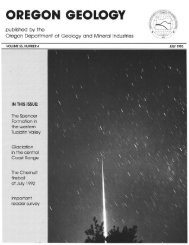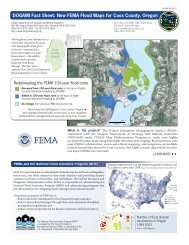Ore Bin / Oregon Geology magazine / journal - Oregon Department ...
Ore Bin / Oregon Geology magazine / journal - Oregon Department ...
Ore Bin / Oregon Geology magazine / journal - Oregon Department ...
You also want an ePaper? Increase the reach of your titles
YUMPU automatically turns print PDFs into web optimized ePapers that Google loves.
GEOLOGY AND REVISED STRATIGRAPHIC INTERPRE<br />
T ATION OF THE MIOCENE SUCKER CREEK FORMA<br />
TION, MALHEUR COUNTY, OREGON, by David C. Lawrence<br />
(M.S., Boise State University, 1988), 54 p.<br />
Miocene volcanic and sedimentary rocks originally mapped as<br />
Sucker Creek Formation near Adrian, <strong>Ore</strong>gon, and Succor Creek<br />
State Park include a stratigraphic section of at least 1,539 m of<br />
westward-tilted and faulted deposits. Mapping indicates a stratigraphic<br />
section that can be divided into four mappable units in<br />
T. 23 S., R. 45 E.; T. 23 S., R. 46 E.; and T. 24 S., R. 46 E.<br />
The main sedimentary section overlies basalts and silicic volcanic<br />
rocks at least 200 m thick, exposed along Succor Creek.<br />
Starting with the basal unit, the section consists of 198 m of bentonitic<br />
claystones containing a white volcanic ash and a prominent<br />
orange sandy siltstone; 31 m of alternating thinly bedded diatomite<br />
(partly altered to porcellanite) and bentonitic claystones; 279 m<br />
of olive-gray bentonitic claystones with several layers of white<br />
volcanic ash and, in the upper part, interbedded with 38 m or<br />
more of conglomerates and gravels. Above this dominantly<br />
claystone basal unit is a 594-m sequence of palagonite tuffs containing<br />
minor basalt flows, dikes and sills, overlain by a rhyolite<br />
dome complex that is locally 107 m thick, then a 19-m thick<br />
zone of thinly-bedded pumice lapilli and ash. The uppermost unit<br />
in the section is a 92-m-thick pale-greenish rhyolite tuff. The basalt<br />
and palagonite unit is apparently localized near and north of Devils<br />
Gate, but the underlying lacustrine claystone section is more widespread<br />
in the region.<br />
The section is broken and partially repeated in several normal<br />
fault blocks. Because the stratigraphic section includes considerable<br />
amounts of claystone, this section contrasts markedly with the<br />
type section, described by Kittleman and others (1965) about 9<br />
km south of this study area. That type section is 178 m of mostly<br />
volcaniclastic sandstone.<br />
The differences in stratigraphic sections indicate that, in this<br />
report and the section described by Kittleman and others, beds<br />
and no one type section can be considered typical. Similar rocks<br />
occur at depths of 2,865-3,828 m beneath the Snake River Plain<br />
near Meridian, Idaho, in the J.N. James well, in a section containing<br />
about 950 m of claystone.<br />
Preliminary synthesis of detailed sections of the formation<br />
mostly indicates that the Sucker Creek Formation indicates bimodal<br />
volcanic rocks, and sedimentary-facies rocks. Volcanic ash layers<br />
in the lacustrine claystones are the best marker beds for regional<br />
correlation, and their recognition may provide a basis for understanding<br />
the basin evolution.<br />
GEOLOGY, GEOCHEMISTRY, AND MINERALIZATION<br />
OF THE YELLOWBOTTOM-BOULDER CREEK AREA,<br />
LINN COUNTY, OREGON, by David K. Nicholson (M.S.,<br />
<strong>Ore</strong>gon State University, 1989 [completed 1988]), 186 p.<br />
The Yellowbottom-Boulder Creek area is immediately west of<br />
the Quartzville mining district in the Western Cascades of <strong>Ore</strong>gon.<br />
Volcanic rocks comprise a series of basaltic to rhyodacitic flows<br />
and volcaniclastic deposits that are believed to correlate with the<br />
Sardine Formation (mid-Miocene). These volcanic rocks dip to<br />
the southeast (5° to 25°), presumably into the hinge zone of the<br />
Sardine syncline located immediately to the east.<br />
Intrusive rocks consist of small stocks of intermediate composition<br />
(quartz diorite, quartz monzodiorite, quartz monzonite,<br />
granodiorite, and tonalite), and dikes and plugs of basaltic to rhyolitic<br />
composition. The largest intrusion is a quartz monzodiorite<br />
stock that covers approximately 1 km 2 , for which the name<br />
Yellow bottom Stock is proposed here.<br />
Pliocene flows of diktytaxitic basalt and porphyritic andesite<br />
of High Cascade origin are preserved on the crests of Galena<br />
Ridge and Packers Divide. A Quaternary flow of trachybasalt partly<br />
fills the valley of Canal Creek and is associated with two cinder<br />
cones: They presumably represent the last pulse of volcanic activity<br />
in the Quartzville area.<br />
Major-oxide concentrations in the volcanic and plutonic rocks<br />
display systematic trends (decreasing Ab03, Ti02, FeOT, MgO,<br />
CaO, and Pl03, and increasing BaO and K20, with increasing<br />
Si02 content) on Harker variation diagrams. These trends may<br />
suggest differentiation from a single batch of magma. The chemistry<br />
of plutonic rocks from the study areas, and from the Western Cascades<br />
in general (calc-alkaline, low K20 content), is similar to<br />
that of some island-arc terranes, including the Southern California<br />
batholith, Caribbean, southwestern Pacific, and Pacific Northwest<br />
areas, and largely suggests that the magma was derived from the<br />
mantle with little if any crustal contamination.<br />
Hydrothermal alteration has affected all rocks of Miocene age.<br />
Propylitic alteration is widespread in areal extent and is thought<br />
to have been produced by the interaction of magmatic fluids with<br />
the host rocks. In contrast, argillic-phyllic alteration is structurally<br />
controlled, and may have resulted from hydrolysis reactions between<br />
the hosts and meteoric waters that invaded the structures subsequent<br />
to propylization. Zones of brecciated and silicified rock range from<br />
linear to cylindrical in shape and are commonly mineralized.<br />
Comparisons of the concentrations of trace metals (Ag, Cu,<br />
Pb, Zn, and Mo) with those in average granodiorite, Caribbean<br />
intrusions associated with porphyry-copper deposits, and rocks of<br />
the Western Cascades indicate that samples of the Yellowbottom<br />
Boulder Creek area are depleted in Cu, Pb, and Zn and enriched<br />
in Ag. Strong correlations are observed (Mo-Ag; Cu-Zn), whereas<br />
Pb has an antipathetic relationship to both Cu and Zn. Trends<br />
derived from data plotted on a Cu-Pb-Zn ternary diagram suggest<br />
that Pb and Zn metallizations are associated with vein-type deposition,<br />
whereas a one-sample Cu anomaly may be related to<br />
porphyry-type mineralization. Mineralized districts to the north<br />
in the Western Cascades are more enriched in copper than the<br />
Yellowbottom-Boulder Creek area, whereas those to the south contain<br />
more zinc. This change in the abundances of trace metals<br />
may be related to the depth of erosion that has exposed deeper<br />
levels of the hydrothermal systems in districts to the north.<br />
Sulfur-isotope data suggest a magmatic source of sulfur. Depositional<br />
temperatures (l5T to 260°C) obtained from sulfurisotope<br />
fractionation and fluid-inclusion data derived from a<br />
quartz-calcite-galena-sphalerite veinlet suggest mineralization during<br />
late-stage gradual cooling of the hydrothermal system.<br />
Several geologic features, including mineralized breccia pipes<br />
and zones, quartz-bearing porphyritic intrusions, and anomalous<br />
metal concentrations, suggest the presence of a porphyry-type hydrothermal<br />
system at depth in the Boulder Creek area. Additionally,<br />
linear zones of intense silicification may be associated with shallower<br />
mineral deposition in the epithermal environment. The future<br />
mineral resource potential of the area is therefore largely, but not<br />
completely, dependent on the discovery of porphyry-type mineralization<br />
that might be enhanced by association with anomalously<br />
high gold and silver concentrations. 0<br />
U.S. POSTAL SERVICE STATEMENT OF OWNER<br />
SHIP, MANAGEMENT, AND CIRCULATION<br />
Publication title: OREGON GEOLOGY, no. 600040; filing date 9-22-89.<br />
Published bimonthly, 6 issues per year, annual subscription price $6. Address<br />
of publication office, publisher's business office, editor, and owner: 910<br />
State Office Building, 1400 SW 5th Ave., Portland, OR 97201-5528. Publisher<br />
and owner: <strong>Ore</strong>gon <strong>Department</strong> of <strong>Geology</strong> and Mineral Industries;<br />
editor: Beverly F. VOgl. No managing editor or bondholders. Circulation<br />
during last 12 months/of single issue, respectively: Net press run 3000/3000;<br />
paid circulation est. 200/200: mail subscription 1553/1545; total paid circulation<br />
1753/1745; free distribution 335/351; total distribution 2088/2096;<br />
not distributed 912/904; return 0/0; total 3000/3000. I certify that the statements<br />
made by me above lJ~ and complete.<br />
"BM~ a . , Publications Manager<br />
OREGON GEOLOGY, VOLUME 51, NUMBER 6, NOVEMBER 1989 141




